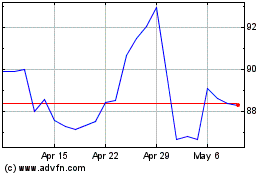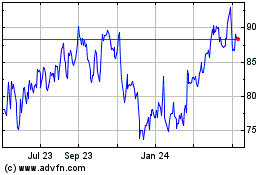Oil-Market Turbulence Whipsaws Junk Bonds
September 17 2019 - 4:10PM
Dow Jones News
By Matt Wirz
Volatility in oil prices is whipsawing the U.S. high-yield bond
market.
Junk bonds of U.S. oil-and-natural gas companies were the most
actively traded corporate securities Tuesday as they retraced much
of their gains from Monday, when oil prices jumped 15% on concerns
about disrupted Saudi Arabian production.
Energy companies account for about 6% of debt outstanding in the
high-yield market, according to data from S&P Global
Ratings.
Even if Saudi Arabia restores oil output faster than
anticipated, high-yield investors are ambivalent about buying back
into the energy sector because of their broader anxiety about
potential deterioration in the economy and credit markets, analysts
said.
"Monday's oil price spike should help somewhat, but the move is
a double-edged sword given escalating recessionary concerns,"
Michael Anderson, a strategist at Citigroup Inc. wrote in a
report.
California Resources Corp. and Chesapeake Energy Corp. were the
top-traded high-yield bond issuers Tuesday as oil prices swung
lower with about $265 million of debt changing hands, according to
data from MarketAxess. California Resources' bond due 2022 dropped
as much as 4.50 cents on the dollar to 58.50 cents on the dollar
Tuesday before rebounding to around 60, while Chesapeake's bond due
2025 dropped as much as 3 cents to 84 cents on the dollar before
rebounding to 86.
A string of bankruptcies in the oil patch triggered a steep junk
bond selloff in late 2015 and many investors fear a permanent
decline in oil prices could set off another round of defaults.
The oil and gas sector has the highest distress ratio -- defined
as the proportion of bonds yielding more than 10 percentage points
over U.S. Treasurys -- of any industry in the junk bond market,
according to data from S&P. The overall junk bond distress
ratio rose to 9.4% in August from about 6% in July, in large part
because of a surge in energy-company bond yields. The distress
ratio for oil and gas producers jumped to 36% from 18% in August,
according to S&P.
The steep increase in borrowing costs for energy companies
coincided with a sharp decline in new bond issuance from the
industry to $5.5 billion through Aug. 16, the lowest level since
2006, according to S&P. Higher borrowing costs can become a
critical problem for companies with below investment-grade credit
ratings because most of them lack the cash to pay debt as it comes
due.
U.S. government-bond yields fell, with the yield on the
benchmark 10-year Treasury note settled at 1.805% Tuesday, compared
with 1.843% Monday. Yields fall as bond prices rise.
The WSJ Dollar Index, which measures the U.S. currency against a
basket of 16 others, fell to 91.17 Tuesday from 91.39.
Write to Matt Wirz at matthieu.wirz@wsj.com
(END) Dow Jones Newswires
September 17, 2019 15:55 ET (19:55 GMT)
Copyright (c) 2019 Dow Jones & Company, Inc.
Chesapeake Energy (NASDAQ:CHK)
Historical Stock Chart
From Mar 2024 to Apr 2024

Chesapeake Energy (NASDAQ:CHK)
Historical Stock Chart
From Apr 2023 to Apr 2024
